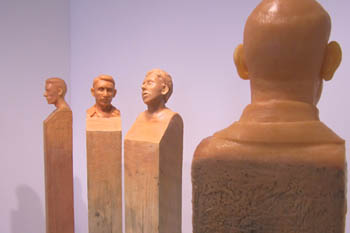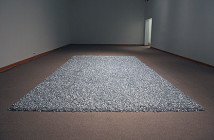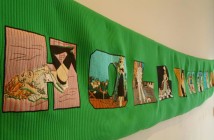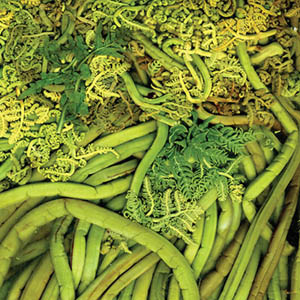In the mid sixties the body came back into art. The human figure had all but disappeared due to the overwhelming dominance of American abstraction, but come back it did – out from under the repressive gaze of formalism. While for some artists the body became a site on which they could resurrect the drawing and rendering banished by late Modernism, for others it offered a place to explore issues like gender, race, sexuality – a new frontier or, to appropriate Barbara Kruger’s terminology, a new “battleground.” Just think of Jasper Johns’ anxiety riddled Target with Plaster Casts. Today an all-figurative show like Standing On One Foot (curated by Art New England Editor-in-Chief Barbara O’Brien) is quite natural, but then, it’s always been easy to take the body for granted.
Sometimes a nuisance can be irresistible, and so I sat for a bit with Heejung Kim’s video, sculpture, and sound piece I eat kimchee but sometimes I disguise it In it a plaster cast of a face is positioned in the center of a wooden bench at whose ends sit a pair of projectors. These project a video loop of a face onto the outside and inside of the mask thus eerily animating it. I wondered whether or not the artist had ever heard of Tony Oursler (who made a career out of animating casts and stuffed dummies with looped video projections -“the body as screen of projection”). The text/sound that accompanies the piece also seemed…shall I say, familiar?…or is it “appropriated”? The face in Kim’s piece laconically repeats a few phrases like: “Hey, will you talk to me?” and the response is always cut off by the question. It reminded me of Bruce Nauman’s work which often riffs on the desperate need to communicate or express and the inability to effectively do so. The pieces inability to communicate followed me around the rest of the gallery.
Jedediah Morfit’s Interactions consists of a group of seven wax casts of heads, smaller than life size, atop pressure treated wooden posts each about five feet high: five of men, young and old, and two of women. The figures seem caught in a moment of thought: they’re together but they are miles apart; isolated, frozen, immobile as the wooden supports upon which they rest. The exception is the bust of the young man, whose expression is quizzical with his head cocked to one side as though he’s listening to a whisper. Morfit shows us that traditional sculpture still has legs even if his casts do not. Despite their silence these sculptures seem far more dramatically “real” than Kim’s plaster cast and video projection that rather noisily asserts its technological impersonality.
Kim redeems herself with her video work titled Without Shoes among those with shoes in which we see only a pair of hands that repeat actions like knocking, slapping and feeling. It’s like watching a mime trying to escape from an imaginary cell, only here the cell is that of the two dimensional video space. The hands come at us, pleading for our attention and possibly our sympathy. Similarly, her Ha. Take a squeeze of fresh air Ah (her titles are frustrating) presents us with the body in distress. A mouth has been sealed closed with a piece of clear plastic tape and we watch as it struggles to remove it using only facial muscles. She finally triumphs and her reward is simply but importantly to breathe again. These two works succeed in that they highlight the sheer physicality of the body – nothing more is needed.
But of course the body in art can be, and often is, more than the sum of its parts. Barbara Grad chooses the body/mind connection and its roots in mysticism as a starting point for her intriguing work. Each of her polycarbonate etchings (on glass with sepia toned ink) and mixed media drawings is a cosmic wonderland of the body. She references to holistic representations of body energy: chi lines, chakra like diagrams and the like abound. In some the form of the body nearly disappears under the frenetic jumble of signs and symbols. On glass they have a quasi-scientific air about them as if they were x-ray charts, and in a fantastical sense they are. They look at the body as a conduit of energy and meaning – a viewpoint that is widely practiced and respected in non-western medicine. Her work resurrects questions about the body’s relationship to the cosmos and her work serves as a good counterpoint to Kim’s and Morfit’s, who proclaim its fleshy reality.
For all its apparent reserve Morfit’s work has an anxious side and nowhere is this more on display than in his dueling sumo wrestlers. One is about life size all white and the other is in miniature – a virtual copy but in black. It’s a study in opposites squaring off. I got down on my hands and knees to be sure and my suspicion was confirmed- these wrestlers are women. And so yet again another opposite (sumo wrestling is traditionally a male sport) is met and resolved within this perplexing work. The larger one is entitled Carriage and this is because two lifting beams are inserted into its body. It’s a funny pun – who but a sumo wrestler can move a sumo wrestler? Well here is your answer. Thus the confrontation, the challenge is not limited to the sculpted participants but it invites the viewer to at least consider their physical relationship to the work.
Body size is a charged topic in the West where women are expected to fit into size zero jeans. Everywhere else zero is means ‘nothing’, but for many young women it is a goal and means a sad struggle. I think it’s a serious issue and so apparently does Lauren O’ Neil but her work doesn’t rise to the gravity of the situation. O’Neil presents several crude gouache and graphite drawings that vaguely refer to the pains and suffering of the body explained through clothing - such as stretch pants which are drawn with large tears flowing from them. In Crying Chairr, a bland drawing shows a large chair isolated from a group of small ones; the larger one being excluded from the others because of its size. It is an emotional reality for many young women but O’Neil’s chosen metaphor is obvious to the point of parody and her drawings’ exhibited lack of skill and invention hardly helps matters. This is also true of her installation,Uncomfortable Fit, Help Me Stretch My Pants. A graphite silhouette of a torso is drawn directly on the wall and push-pins have been placed around it. From these lines of string attach to a pair of pants lying on the floor. Fashion is a tricky vessel for meaning because fashion can be very superficial, while the body and its concerns are very real. O’Neil’s work comes up short in part because it’s too concerned with being flip with its “skill is nothing compared to ideas” attitude.
Standing On One Foot is, as its name unintentionally implies, a little unbalanced. But the strongest works demonstrate that the body is still as fertile as ever despite its continually changing and controversial identity within the art world and our thoughts.
Links:
Boston Center for the Arts
"Standing on One Foot" is on view until October 30th at the Mills Gallery.
All images are courtesy of the artist, the Mills Gallery and Google image search.




